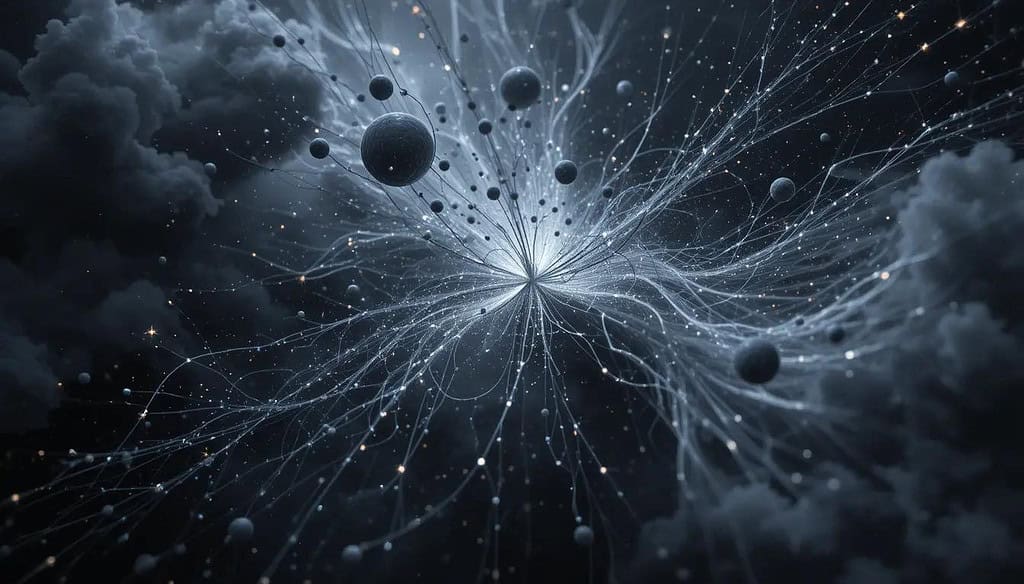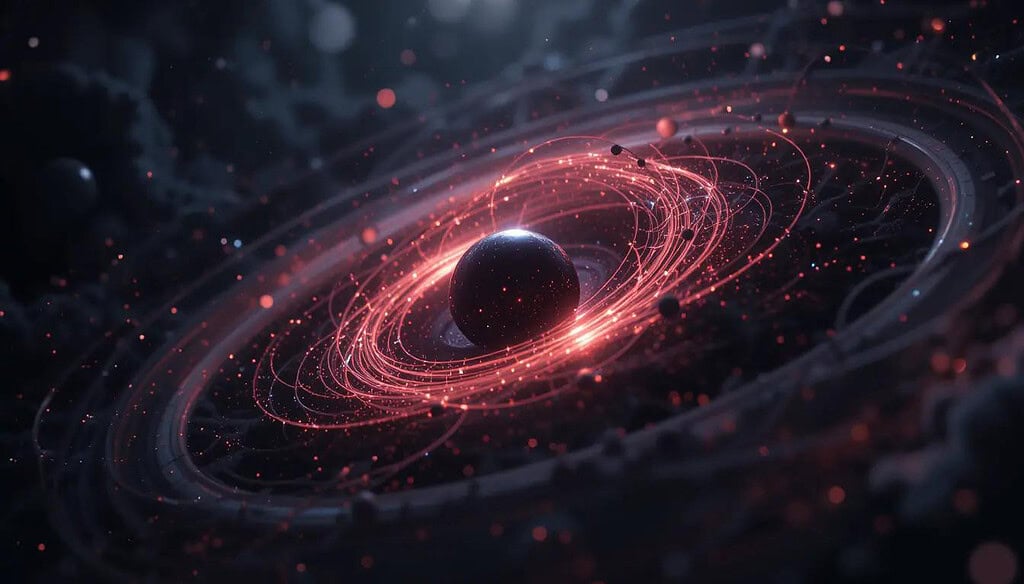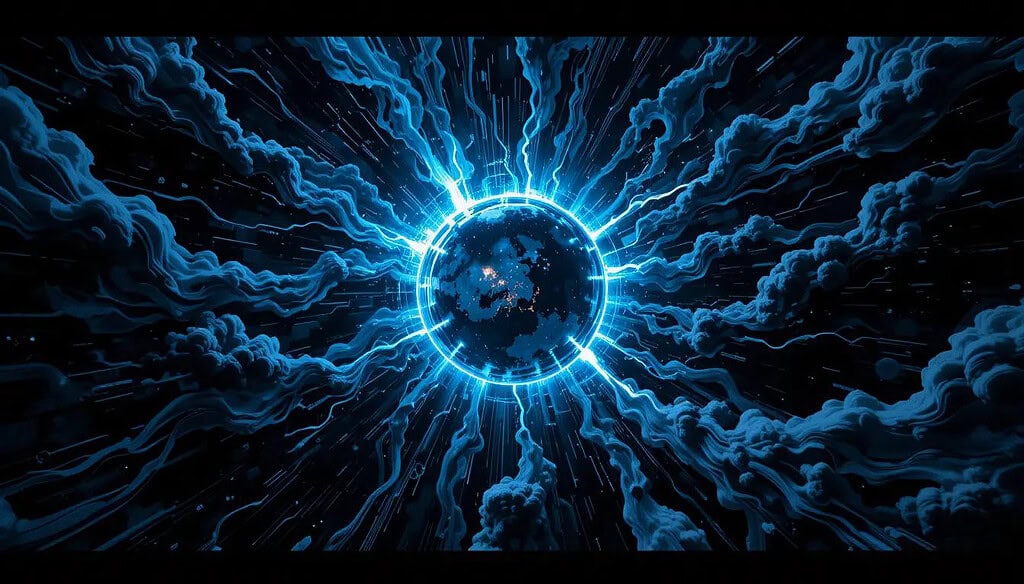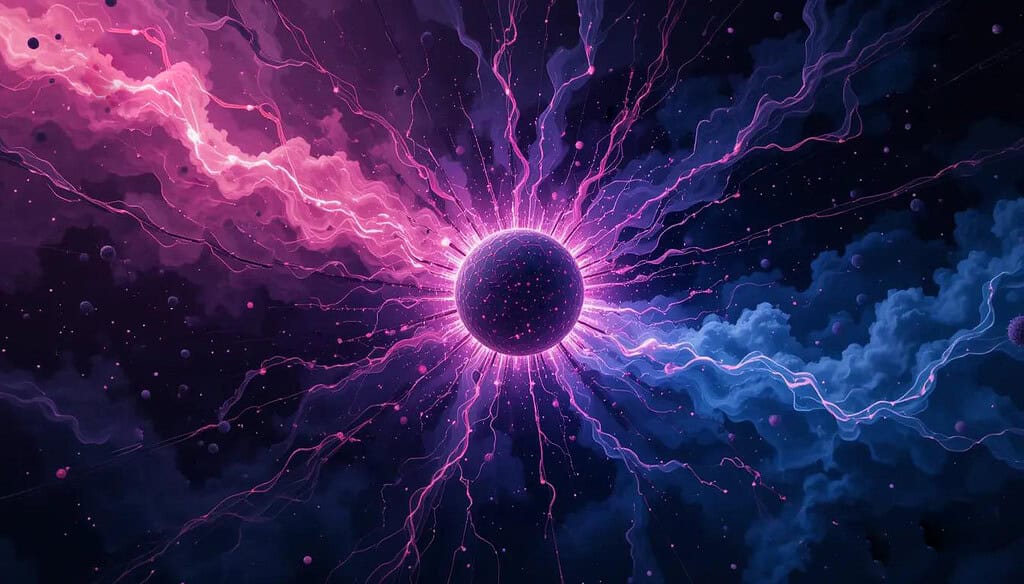Table of Contents
Cosmic Mystery of Dark Matter

Imagine embarking on an epic treasure hunt, one where the treasure is not a chest filled with gold or jewels but the secrets of the universe itself. Dark matter, the elusive and mysterious substance that makes up about 85% of the universe’s mass, is exactly that—a cosmic treasure we’re desperate to uncover. It doesn’t glow, doesn’t interact with light, and, frustratingly, can’t be seen. Yet, it holds galaxies together and shapes the very fabric of the cosmos. Talk about a powerful, invisible force!
The story of dark matter begins with a mystery: why don’t galaxies fly apart? Decades ago, scientists realized something strange. Based on the visible mass of galaxies, their rotation speeds didn’t add up. It was as if an invisible hand was keeping them intact. That invisible hand was dubbed “dark matter,” and ever since, astronomers and physicists have been following the clues, piecing together this grand puzzle.
Think of dark matter as the ultimate treasure hidden in the attic of the universe. Scientists have their maps—data collected from telescopes, particle detectors, and space observatories—but the X that marks the spot remains elusive. Each clue, from the bending of light around galaxies to the way clusters of stars behave, brings us closer to the treasure. It’s like finding breadcrumbs in a dense forest, each one a tantalizing hint of the prize ahead.
But this hunt isn’t just about satisfying curiosity; it’s about understanding the universe’s biggest secrets. What if we could finally “see” dark matter, or even hold it in our hands? It’s the kind of question that keeps scientists awake at night. The pursuit of dark matter is not just about the end result—it’s about the journey, the discoveries along the way, and the thrill of chasing the unknown.
Dark matter reminds us that some of the universe’s most powerful forces are the ones we can’t see. And like every great treasure hunt, the challenge isn’t just finding the treasure—it’s proving we have the courage and ingenuity to keep searching. So here we are, adventurers of the cosmos, determined to uncover the ultimate prize hidden in the stars.
8 Steps of the Cosmic Treasure Hunt for Dark Matter

Step 1: The Call to Adventure – The Mystery of the Missing Mass
Every treasure hunt begins with a question, doesn’t it? A map on a dusty table, an old riddle, or a clue that doesn’t quite make sense. For dark matter, that question came in the form of spinning galaxies. Back in the mid-20th century, astronomers noticed something weird. Galaxies were rotating so fast that, according to the visible mass they contained, they should have been torn apart. But they weren’t. Something unseen, some invisible force, was holding them together. It was as if the universe had a secret up its sleeve—a treasure waiting to be found.
The clue was undeniable, but it raised more questions than answers. If this “missing mass” existed, why couldn’t we see it? Why didn’t it emit light or interact with anything we could detect? Scientists dubbed it “dark matter,” but the name didn’t solve the mystery. It just put a label on the unknown. The hunt was officially on.
This initial discovery was like finding the first breadcrumb in a dense forest. It hinted at something huge, something that could change how we understood the universe. But it also meant stepping into the unknown, armed with only questions and a growing sense of curiosity. That’s the beauty of a good adventure—it starts with a mystery and a hint of something extraordinary just beyond reach.
Step 2: Gathering the Map – Theoretical Foundations
Before you set out on a treasure hunt, you need a map—or at least an idea of where to start. For dark matter, the map began taking shape through theories. Scientists couldn’t see dark matter directly, so they started imagining what it could be. Maybe it was made of unknown particles that didn’t interact with light. Maybe it was a form of invisible gas. Or maybe it wasn’t matter at all but something entirely new.
These theories were like sketching out possible routes on a blank piece of paper. Each hypothesis added a new line, a new X to mark the spot. Physicists came up with concepts like Weakly Interacting Massive Particles (WIMPs), axions, and sterile neutrinos—particles that could exist but hadn’t been detected yet. It was like inventing a language to describe a treasure no one had ever seen.
But the map wasn’t just guesswork. Observations from telescopes and experiments gave scientists clues to refine their theories. The way galaxies clustered, the bending of light from distant stars, and the echoes of the Big Bang all pointed to the existence of dark matter. Slowly, the map became more detailed, though it was still far from complete.
Gathering the map was all about preparation—thinking creatively, testing ideas, and figuring out where to look next. After all, every great hunt starts with a plan, even if the real journey ends up full of surprises.
Step 3: Following the Footprints – Indirect Clues in Space
Imagine you’re hunting for treasure, and you spot footprints leading through the sand. You can’t see the treasure yet, but those tracks tell you you’re on the right path. That’s what scientists faced with dark matter: indirect evidence that something was out there, even if they couldn’t see it directly.
One of the most fascinating signs of dark matter is gravitational lensing. This phenomenon occurs when light from a far-off star or galaxy is bent around a massive object, such as a galaxy cluster. Interestingly, the amount of bending often doesn’t correspond to the visible mass in the cluster, suggesting there’s an unseen force at play. That force? Dark matter.
Then there’s the movement of stars within galaxies. Stars near the edges of galaxies are moving way too fast as if they’re getting an extra gravitational pull. But there’s no visible mass to explain it. Once again, dark matter seems to be the culprit, leaving its invisible tracks across the cosmos.
Following these footprints has been like piecing together a trail through a dense forest. Every clue tells us we’re on the right path, even if the treasure itself remains hidden. It’s the kind of hunt that requires patience, creativity, and a little bit of luck. And with every new footprint, the excitement builds: What will the next clue reveal?
Step 4: Searching the Terrain – Using Tools like the Large Hadron Collider
A skilled treasure hunter understands that having the right equipment can significantly impact their success. Similarly, scientists on the hunt for dark matter rely on some of the most sophisticated technology available. For instance, the Large Hadron Collider (LHC) serves as a powerful tool, akin to a high-tech shovel that digs deep into the universe’s mysteries.
According to CERN, The LHC works by smashing proton beams together at incredible speeds, almost 99.99% of the speed of light. It recreates the conditions similar to those just after the Big Bang. The temperature could reach Millions of Kelvin. It is interesting to note that the temperature of the LHC is around 1.9 K or -271°C. Helium-4 superfluid is used to keep the LHC at this extremely low temperature.
The idea is that these collisions would produce dark matter. But the dark matter does not interact with ordinary matter. So it would escape through the LHC and scientists will be able to detect the mission energy. It’s like sifting through dirt and hoping to catch a glimmer of gold. So far, no direct evidence of dark matter has been found, but the search has revealed plenty of other fascinating physics, proving that even the hunt itself is full of rewards.
Additionally, there are detectors located deep underground, carefully shielded from cosmic rays and other background interference. These detectors act like treasure chests, poised to capture the slightest evidence of dark matter particles interacting with ordinary matter. Each experiment brings researchers one step closer to revealing the truth, even if the ultimate discovery remains just beyond their grasp.
Searching the terrain isn’t easy, but it’s what makes the hunt so exciting. Each tool brings us closer to understanding the universe’s secrets, turning science into the ultimate adventure.
Step 5: The Hidden Treasures – Dark Matter Particles
What exactly is the treasure we’re looking for? In the case of dark matter, scientists believe the prize is a type of particle we haven’t discovered yet. These particles are like the gems hidden in the treasure chest—small, elusive, and incredibly valuable.
One popular candidate is the WIMP, or Weakly Interacting Massive Particle. WIMPs are theorized to be heavy and stable, interacting only weakly with normal matter. If they exist, they could explain the missing mass in the universe. Another contender is the axion, a lightweight particle that might help solve some of physics’ biggest puzzles. And then there are sterile neutrinos, shadowy cousins of the neutrinos we already know about.
Finding these particles would be like discovering an entirely new element of the universe, one that’s been hiding in plain sight. It’s not just about proving they exist—it’s about unlocking a deeper understanding of how the cosmos works. Each potential dark matter particle is a piece of the puzzle, waiting to be placed in the bigger picture.
The hunt for these particles is a reminder that even the smallest treasures can have the biggest impact. Who knows? The discovery of dark matter particles could change everything we thought we knew about the universe.
Step 6: The Labyrinth – Challenges and Setbacks
Every treasure hunt has its obstacles, and the search for dark matter is no different. If anything, it’s like navigating a labyrinth with twists, turns, and dead ends at every corner. The biggest challenge? Dark matter doesn’t interact with light, making it invisible. It’s like searching for a treasure chest made of air—you know it’s there, but you can’t see or touch it.
Then there’s the issue of background noise. Earth is constantly bombarded by cosmic rays, radioactive decay, and other signals that can interfere with experiments. Filtering out this noise is like trying to hear a whisper in the middle of a crowded concert. It requires incredible precision and patience.
And let’s not forget the countless failed experiments. Every time scientists come up empty-handed, it feels like hitting a dead end in the labyrinth. But each setback is also a learning opportunity, helping refine the search and guiding scientists closer to the goal.
The labyrinth is frustrating, sure, but it’s also what makes the hunt so compelling. Every obstacle overcome is a step closer to the treasure, proving that persistence and ingenuity are the keys to success.
Step 7: The Big Discovery – A Major Breakthrough
Imagine the moment when a treasure chest finally opens, revealing its glittering contents. For dark matter, that moment would be a scientific breakthrough of epic proportions. Maybe it’s a particle detected in an underground lab, or a signal from space that defies all expectations. Whatever form it takes, the discovery of dark matter would be a game-changer.
A major breakthrough would confirm what scientists have suspected for decades—that dark matter is real, and it plays a crucial role in the universe. But it would also open up a whole new set of questions. What are the properties of dark matter? How does it interact with normal matter? And what does it tell us about the origins of the universe?
This moment would be like finding a treasure map hidden inside the chest, pointing to even greater mysteries. It’s the kind of discovery that would ripple through every field of science, inspiring new ideas and experiments.
The big discovery isn’t just about solving a puzzle—it’s about unlocking the next chapter of the story. And for scientists, that’s the ultimate prize.
Step 8: The Treasure Revealed – Understanding the Cosmic Role of Dark Matter
At last, we arrive at the treasure chest. But what awaits us inside? When it comes to dark matter, the true reward lies not only in its discovery but in grasping its significance for the universe. Dark matter is more than just an intriguing mystery; it serves as the binding force that keeps galaxies intact, the very framework of the cosmos. Without it, the universe we recognize simply wouldn’t be here.
Revealing the treasure would give us a clearer picture of how the universe was born, how it evolved, and where it’s headed. It would answer some of the biggest questions in science while raising new ones. And it would remind us that even the most invisible forces can have the greatest impact.
The treasure of dark matter is more than just a discovery—it’s a revelation. It’s the moment when we realize how much we’ve yet to learn and how far we’ve come on this incredible journey. And isn’t that what every great treasure hunt is really about?
Treasure Hunt Continues: The Future of Dark Matter Research

Every great treasure hunt leaves you on the edge of your seat, doesn’t it? Even when you’ve found a few clues, the journey doesn’t end—it only gets more thrilling. That’s where we are with dark matter. We’ve picked up tantalizing hints, gathered promising data, and devised incredible tools. But the treasure chest? It’s still hidden, and the map only grows more intricate.
Think of the Large Hadron Collider as one of those fancy gadgets in an adventurer’s toolkit. Scientists are smashing particles together at unimaginable speeds, hoping to stumble upon dark matter particles—or at least a whiff of their existence. It’s like shaking a treasure chest to see if something inside rattles. And while the chest hasn’t popped open yet, the shaking has revealed fascinating new physics that we didn’t even know we were looking for.
Meanwhile, astronomers have their own treasure maps. They’re using telescopes like the Vera C. Rubin Observatory to study the faintest clues in the night sky—how light bends as it passes through galaxies, how stars dance in clusters, and even how entire galaxies behave like characters in a cosmic play. These observations are like deciphering cryptic symbols on a centuries-old parchment. Each clue adds to the story, bringing us closer to the treasure.
But here’s the plot twist: what if dark matter isn’t what we think it is? What if the treasure is something entirely different—something we can’t even imagine yet? This is the part of the hunt that’s most exciting. Scientists aren’t just searching for dark matter; they’re challenging the very rules of the universe, rewriting the story of reality as we know it.
The treasure hunt continues with new missions, experiments, and theories on the horizon. Every step forward is a reminder of why we started this quest in the first place: to understand the invisible forces that shape our universe. And while we haven’t cracked the final code, the thrill of the chase is what makes the journey unforgettable.
Dark Matter and the Ever-Unfolding Mystery of the Cosmos

Every treasure hunt needs a good ending, right? But here’s the twist with dark matter: the story isn’t over. In fact, it’s just getting started. The search for this cosmic enigma is one of the most captivating quests humanity has ever undertaken, and every step we take brings us closer to understanding the universe’s deepest secrets.
Dark matter is like the ultimate prize in a never-ending game of hide-and-seek. We know it’s out there, pulling galaxies together, shaping the universe, and leaving clues in its wake. But finding it? That’s the real challenge. And maybe, just maybe, the greatest treasures aren’t the ones you immediately uncover but the ones that keep you searching, wondering, and dreaming.
What makes this hunt so extraordinary is the journey itself. Along the way, we’ve invented groundbreaking technology, discovered phenomena we never expected, and deepened our understanding of the cosmos. The search for dark matter isn’t just about solving a mystery—it’s about expanding the boundaries of human knowledge and imagination.
Where do we head next? The quest will carry on, fueled by the curiosity and resolve of researchers globally. Perhaps the next significant discovery is just within reach. It could be lurking in a distant galaxy or concealed within the smallest particles of our universe. No matter what, the pursuit of dark matter serves as a reminder that the cosmos is immense, enigmatic, and brimming with wonders.
In the end, the greatest treasures aren’t just the ones we find—they’re the ones that inspire us to keep exploring. Dark matter is the perfect reminder that some mysteries are worth the chase, no matter how long it takes to uncover the truth. That’s what makes this cosmic treasure hunt so extraordinary.
Disclaimers: *This article is only for informational purposes.
**Do not make your important decisions solely based on the information provided in this article. Do your own research.
***Information in this article may vary or get updated in the future.
Read More Science and Space Articles
- Blood Orange Adventures: Around the World in 8 Recipes
- Black Hole: 8 Stages Of Its Epic and Extraordinary Life
- Supernova Treasures: 8 Heavenly Metals Shaping Jewelry
- 8 Remarkable Ways Kumquat Shines in Culture and Cuisine
- Beautiful Art of Gravity: 8 Ways It Shapes Our Daily Lives
- 8 Amazing Lime Tales: Ancient Groves to Modern Kitchens
- 8 Weird Ways Grapefruit Can Interfere with Medications
- Pomelo in Culture: 8 Heartwarming Ritual Traditions
- 8 Culinary Uses of Oranges That I Highly Recommend
- 8 Astounding Ways Lemons Have Helped Elevate My Mood
- 8 Irresistible Ericaceae Fruits (Heath Family) to Savor and Enjoy
- 8 Incredible and Healthy Cucurbitaceae Fruits to Enjoy
- Top 8 Delicious Anacardiaceae Fruits You Must Try
- 8 Incredible Musaceae Fruits You Need to Try Right Now
- 8 Incredible Vitaceae Fruits: Nature’s Tasty Treasures
- 8 Incredible Rosaceae Fruits You Need to Discover
- Discover 8 Fruit Families That Enrich Our Daily Diets
- 8 Non-CO₂ Greenhouse Gasses That Are Worst Than CO₂




